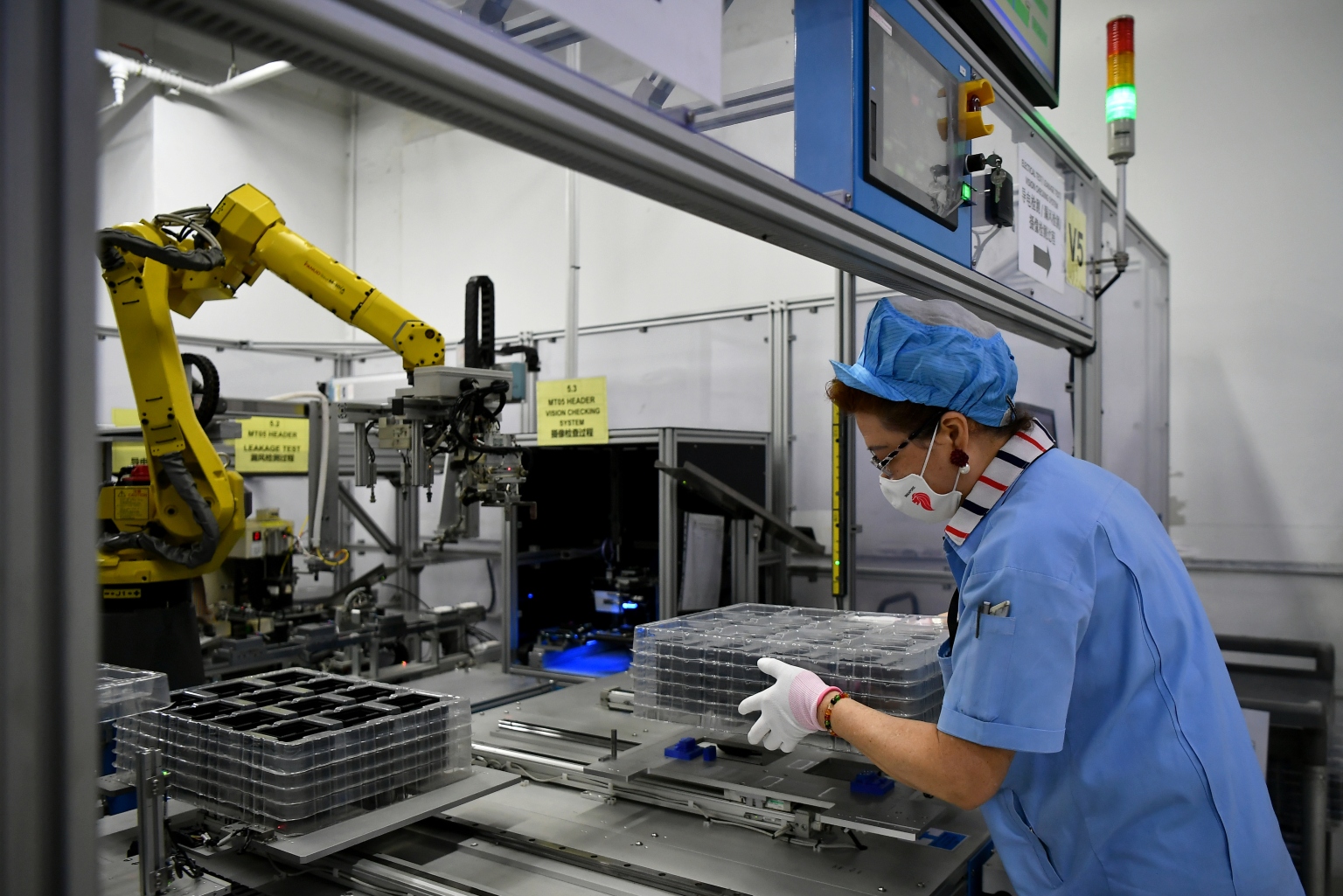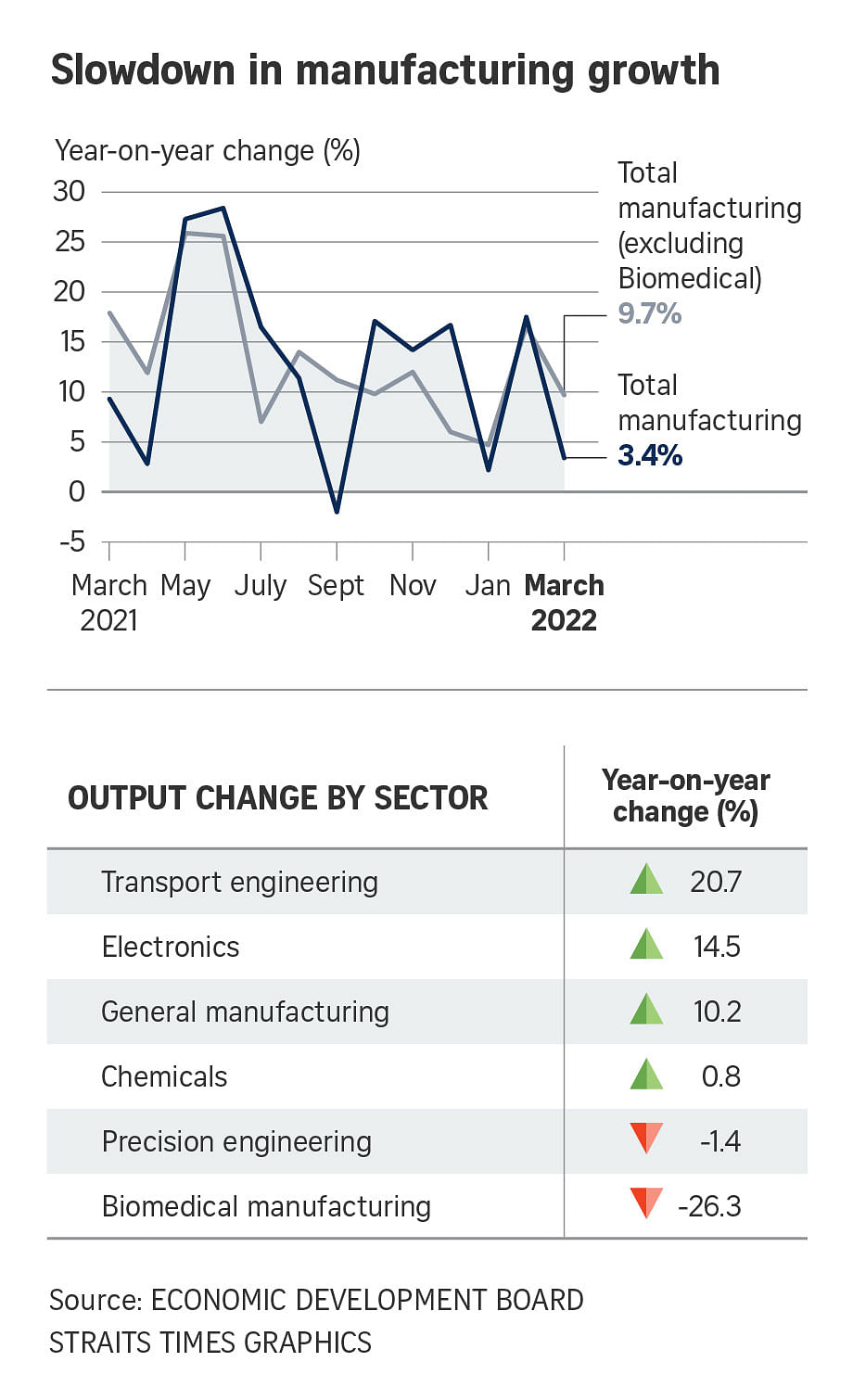Growth in Singapore factory output slows to 3.4% in March as pharma production falls
Sign up now: Get ST's newsletters delivered to your inbox

The manufacturing sector is a significant contributor to Singapore's economy.
PHOTO: ST FILE
Follow topic:
SINGAPORE - Growth in Singapore's manufacturing output slowed in March after a strong performance in February, on the back of a fall in pharmaceutical production.
While growth eased, it marks the sixth straight month of expansion, data from the Economic Development Board (EDB) showed on Tuesday (April 26).
Factory output increased 3.4 per cent last month on a year-on-year basis, down from the revised 17.5 per cent growth in February.
This is higher than the 2 per cent growth forecast by analysts in a Bloomberg poll.Excluding biomedical manufacturing, output grew 9.7 per cent year on year, down from the 16.6 per cent growth in February.
On a seasonally adjusted month-on-month basis, manufacturing output shrank 12.6 per cent in March. Excluding biomedical manufacturing, output fell 6.1 per cent.
UOB said in a note that the robust showing in the manufacturing sector is underpinned by the global trade recovery and the reopening of borders.
Mr Song Seng Wun, economist at CIMB Private Banking, added that the manufacturing numbers highlight the resilience of the consumer.
He expects economic activities to normalise further and said readings of mid-single digit growth are more reflective of these normal times.
Taking a closer look at the different clusters, the key electronics sector saw output grow 14.5 per cent in March compared with a year ago. All segments recorded growth, except for computer peripherals and data storage, which dipped 4.3 per cent.
Within electronics, the semiconductor segment recorded the strongest performance of 17.3 per cent, after the 39 per cent growth in February.
The sector continues to be supported by sustained demand from 5G markets and data centres amid the global chip shortage, EDB said.
Mr Song said if not for the chip shortage, the sector could have logged in an even stronger performance.
Data from the region showed Asia-Pacific semiconductor sales soaring 41.4 per cent on-year in February, the highest growth since June 2010.
The worst performer was the volatile biomedical manufacturing cluster, whose output fell 26.3 per cent in March, reversing from a 26.1 per cent rise in February.
On a seasonally adjusted month-on-month basis, manufacturing output shrank 12.6 per cent in March. Excluding biomedical manufacturing, output fell 6.1 per cent.
UOB said in a note that the robust showing in the manufacturing sector is underpinned by the global trade recovery and the reopening of borders.
Mr Song Seng Wun, economist at CIMB Private Banking, added that the manufacturing numbers highlight the resilience of the consumer.
He expects economic activities to normalise further and said readings of mid-single digit growth are more reflective of these normal times.
Taking a closer look at the different clusters, the key electronics sector saw output grow 14.5 per cent in March compared with a year ago. All segments recorded growth, except for computer peripherals and data storage, which dipped 4.3 per cent.
Within electronics, the semiconductor segment recorded the strongest performance of 17.3 per cent, after the 39 per cent growth in February.
The sector continues to be supported by sustained demand from 5G markets and data centres amid the global chip shortage, EDB said.
Mr Song said if not for the chip shortage, the sector could have logged in an even stronger performance.
Data from the region showed Asia-Pacific semiconductor sales soaring 41.4 per cent on-year in February, the highest growth since June 2010.
The worst performer was the volatile biomedical manufacturing cluster, whose output fell 26.3 per cent in March, reversing from a 26.1 per cent rise in February.
March’s decline also marked the sharpest fall in the sector since September 2021, when biomedical output fell 35.8 per cent year-on-year.
The key drag was the pharmaceuticals segment, which shrank 39 per cent due to a different mix of active pharmaceutical ingredients being produced, said EDB.
The key drag was the pharmaceuticals segment, which shrank 39 per cent due to a different mix of active pharmaceutical ingredients being produced, said EDB.
The medical technology segment contracted 7.1 per cent because of lower export demand for medical devices, it added.
Economists, like Mr Song, remain optimistic about the biomed sector, as it is a very high-value-added activity.
He added that Singapore remains an attractive location for vaccine makers and the biomed industry to invest and expand their output, even though it is never the cheapest place for them.
Last week, French healthcare company Sanofi broke ground on its vaccine facility here.
Other players that have manufacturing facilities here include German firm BioNTech and India-based Hilleman Laboratories, a joint venture between pharmaceutical firm Merck and charitable foundation Wellcome Trust.
The other notable sector performance this month was the transport engineering sector. Output increased 20.7 per cent year on year in March, led by the aerospace segment, which grew for the third straight month.
The 39.3 per cent rise in aerospace was underpinned by higher production of aircraft parts and the increase in maintenance, repair and overhaul activities as global travel demand recovers gradually.
There were also more offshore project activities in March, which led to the 7.9 per cent year-on-year rise in the marine and offshore engineering segment.
Other clusters that saw growth in March include the general manufacturing and chemicals sectors. Chemicals output grew 0.8 per cent year on year in March, while general manufacturing output rose 10.2 per cent.
However, the precision engineering cluster saw output decrease 1.4 per cent in March.
The machinery and systems segment fell 0.5 per cent because of the high production base a year ago, while the precision modules and components segment contracted 2.9 per cent with lower production of optical products and wire and cable products.
Economists, like Mr Song, remain optimistic about the biomed sector, as it is a very high-value-added activity.
He added that Singapore remains an attractive location for vaccine makers and the biomed industry to invest and expand their output, even though it is never the cheapest place for them.
Last week, French healthcare company Sanofi broke ground on its vaccine facility here.
Other players that have manufacturing facilities here include German firm BioNTech and India-based Hilleman Laboratories, a joint venture between pharmaceutical firm Merck and charitable foundation Wellcome Trust.
The other notable sector performance this month was the transport engineering sector. Output increased 20.7 per cent year on year in March, led by the aerospace segment, which grew for the third straight month.
The 39.3 per cent rise in aerospace was underpinned by higher production of aircraft parts and the increase in maintenance, repair and overhaul activities as global travel demand recovers gradually.
There were also more offshore project activities in March, which led to the 7.9 per cent year-on-year rise in the marine and offshore engineering segment.
Other clusters that saw growth in March include the general manufacturing and chemicals sectors. Chemicals output grew 0.8 per cent year on year in March, while general manufacturing output rose 10.2 per cent.
However, the precision engineering cluster saw output decrease 1.4 per cent in March.
The machinery and systems segment fell 0.5 per cent because of the high production base a year ago, while the precision modules and components segment contracted 2.9 per cent with lower production of optical products and wire and cable products.

According to EDB, precision engineering is the backbone of the manufacturing industry because it supplies critical products and expertise needed to manufacture complex components and equipment used in various industries, including the semiconductor, medical technology and marine and offshore industries.
With the latest industrial production data, Singapore’s manufacturing growth has clocked 7.1 per cent year-on-year growth in the first quarter of 2022.
The manufacturing sector is a significant contributor to Singapore’s economy, accounting for 20 per cent of gross domestic product.
With the latest industrial production data, Singapore’s manufacturing growth has clocked 7.1 per cent year-on-year growth in the first quarter of 2022.
The manufacturing sector is a significant contributor to Singapore’s economy, accounting for 20 per cent of gross domestic product.

